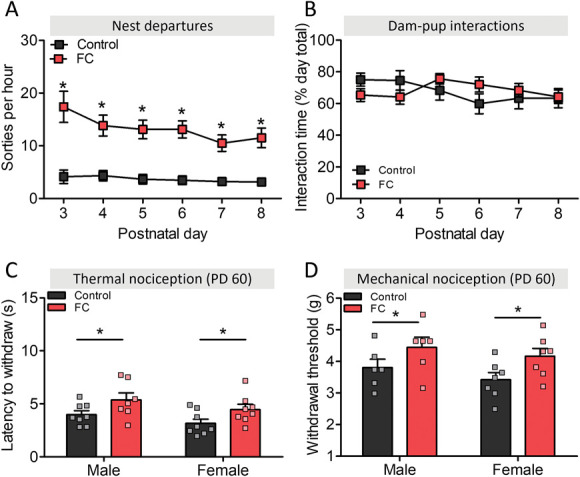Figure 1.

Fragmented care reduces acute thermal and mechanical nociception in wild-type male and female C57BL/6 mice. (A) Dams housed in fragmented care (FC) cages made significantly more nest departures compared with dams housed in control cages on postnatal day (PD) 3 to 8 (cage condition: F1,100 = 52.5, P < 0.0001; time F5,100 = 1.7, P = 0.15; interaction: F5,100 = 0.89, P = 0.49). (B) The time each dam spent interacting with their pups (expressed as a percentage of the total interaction time on each day) was similar between control and FC cages (cage condition: F1,100 = 0.05, P = 0.82; time F5,100 = 0.88, P = 0.5; interaction: F5,100 = 1.9, P = 0.1). (C) Mice exposed to FC during PD 2 to 9 had significantly prolonged tail withdrawal latencies from warm water (48°C) at PD 60 (cage condition: F1,27 = 8.1, P = 0.01; sex: F = 3.3, P = 0.08; interaction: F1,27 = 0.01, P = 0.93). (D) A separate cohort of mice exposed to FC during PD 2 to 9 had significantly enhanced mechanical thresholds on PD 60 (cage condition: F1,22 = 6.9, P = 0.02; sex: F = 1.6, P = 0.22; interaction: F = 0.04, P = 0.85). Statistical comparisons were performed using a 2-way ANOVA with Bonferroni correction. Data shown as mean ± SEM (bars) in all cases. Individual responses from each mouse are shown as separate datapoints. (A and B) n = 10 (control) and n = 12 (FC) separate cages. (C and D) n (control, then FC) = 14 and 13 (WT male), n = 15 and 15 (WT female). * P < 0.05 compared with control. ANOVA, analysis of variance; WT, wild-type.
